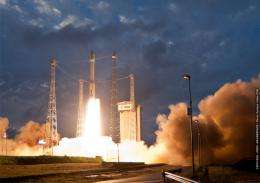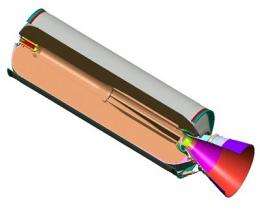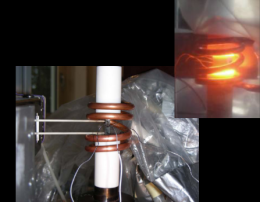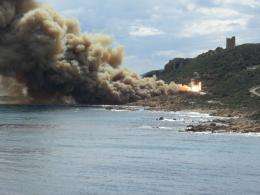Building Vega meant testing materials to their limits

When the first of Europe’s Vega rockets thundered skywards on 13 February, it was a new design based on some novel materials. Such novelty called for rigorous technical risk management by ESA’s materials specialists.
Vega is aimed at carrying small and medium satellites, increasing the flexibility and competitiveness of Europe’s launcher family. It incorporates a wide range of new materials to keep its own mass low: the lighter Vega is, the more payload it can haul to orbit.
Vega’s design is guided by decades of experience building and flying Ariane launchers, with its first three solid-fuel stages derived from Ariane 5’s strap-on boosters.
A reignitable liquid-propellant fourth stage completes delivery of Vega payloads into orbit as well as hosting the avionics and thrusters to oversee the entire stack’s roll control throughout its flight.
Like any other ESA project, the Vega team had at their service the specialist engineering teams and laboratories at ESA’s technical centre ESTEC in Noordwijk, the Netherlands.
Materials experts focused on choosing and qualifying materials for the demanding space environment and worked closely with the Vega project team as the launcher took shape.
“It has been out of the ordinary to work on a launcher,” says Tommaso Ghidini, Head of the Materials Technology Section at ESTEC.
“Instead of hardware that has to go on operating in space for years on end, Vega’s working lifetime lasts slightly more than an hour – but it still has to function without flaw throughout that time.
“Launcher materials really get stressed to their limits: extremely high temperatures combine with high pressures and additional stresses due to shock, vibration, aerodynamic and acoustic forces.
“So the principle is the same, and we assisted the project and the industry side when they ran into difficulties.
“We carried out testing on their behalf, investigated when particular materials didn’t perform as planned and advised on alternatives if necessary.”

Starting at the bottom
ESA’s materials specialists made contributions to various elements of Vega – starting at the very bottom.
The nozzles of the new rocket face some of the most demanding performance requirements of all. Vega’s Zefiro-23 second stage and Zefiro-9 third stage both have nozzles made from carbon phenolic composite material.
This composite has a tendency to ‘ablate’ – flake away – at very high temperatures, so much so that it is sometimes used as a heatshield for re-entering spacecraft: this flaking effect comes in handy as a way of dumping frictional heat.
“Carbon phenolic is a difficult material to test because it loses mass at high temperature – it starts getting thinner,” Tommaso recalls.
“The challenge was allowing for this in real-world testing while still gaining insight into its mechanical properties under stress.
“We use grips to introduce pull stress, but that would be no use if the material then thins out so much it tears once it is heated.
“So we had to design a more dynamic kind of test, with grip jigs kept cold and heating applied to those parts of the sample where we needed it. We applied the results to a new structural model of the motor for further diagnosis.”
The model supported the structural design of the nozzle which then passed a full-scale static firing test at Italy’s Salto di Quirra test range in Sardinia, enduring the equivalent of nearly 120 tonnes of force and flame temperatures of up to 3000 K.
“This was the first time that carbon phenolic underwent such detailed testing in Europe,” adds Tommaso.

“We appreciate very much our cooperation with ESA,” agrees Francesco Betti of Avio, prime contractor for the first three Vega stages. “Their technical expertise and the fact that we could use the ESA labs have helped us significantly.”
Another type of testing was less dramatic but equally necessary to understand how Vega would cope with its environment in the days, weeks or perhaps months a launcher might wait to be flown.
“Vega’s launch site in French Guiana is one of the worst locations you could think of in terms of corrosion,” Tommaso explains.
“It is very warm and humid, with salty sea air, and wind that blows from a single direction so the same section is always getting affected.
“And then there are other launches taking place in the vicinity producing hydrochloric acid in their exhaust with the potential to accelerate corrosion.”
ESA literally wrote the book on many types of corrosion testing, drafting shared standards used throughout Europe’s space industry through an initiative called the European Cooperation for Space Standardization (ECSS).
“We performed various types of standard corrosion and stress corrosion testing,” says Tommaso, the latter needed because the tendency for environment-driven degradation increases markedly when the material is under stress.
“For instance, we performed 'alternate immersion testing' where a sample is placed in salty water for 10 minutes at a time then taken out for 50 minutes, repeatedly for 30 days on end.”
Additional tests roamed further from the lab. For instance, some ‘stringers’ – the structural bones onto which the launcher’s skin is attached – and separation springs in the interstage joining the second and third stages were taken from Vega’s initial qualification model to be put on the same journey Vega itself would make.

“With the stringers we also carried out a shipment test,” Tommaso adds. “This means carrying them in the same container, on the same ship as Vega would be carried in, then have them experience the French Guiana environment.
“This shipment test confirmed directly the structure was fit for purpose.”
Getting the shakes
ESTEC’s materials team also contributed to Vega’s topmost stage, the Attitude and Vernier Upper Module (AVUM). This is the smallest of the stages, because it requires much less power to steer the remaining segment of rocket outside Earth’s atmosphere. Unlike the solid stages, its liquid-propellant motor is throttleable and even reignitable in nature.
AVUM also hosts the majority of avionics used to oversee the launcher’s flight, as well as the batteries serving as Vega’s onboard power source.
“In the case of the satellites we normally work with, launcher payloads can expect some degree of dampening from the vibration and shock of launch,” says Tommaso.
“Obviously that can’t be the case with the actual launcher electronics – they have to endure all the forces put their way.”
The specialists assessed the qualification of the printed circuit boards and surface mounting technology, as well as examining the initially fault-prone ‘tabs’ linking the batteries with Vega’s avionics.
And with those avionics becoming potentially susceptible to space radiation as they rise above the shielding effects of the atmosphere, extensive radiation effects evaluation was performed in ESTEC’s Materials and Electrical Components Laboratories.
A dedicated components examination board was set up with representatives of Vega’s European Launch Vehicle company and ESA’s components division as permanent members, receiving assistance from other experts as needed.
This board had responsibility for selecting, procuring, evaluating and qualifying all Vega’s components electrical, electronic and electro-mechanical (EEE) components - no simple task when the list of components involved runs to more than 600 pages. Some 42 meetings or teleconferences were carried out with component subcontractors over the course of the board’s work.
Tackling fuel tanks
They took a similar approach to AVUM’s quartet of Russian-made fuel tanks, containing fuel and oxidizer.
“We examined the welding of the tanks in a similar fashion, to look for ways they could be improved,” says Tommaso.
They produced a full metallurgical analysis of the welds, and came up with new protocols to improve their microstructure – the improved tanks standing up to more than twice their intended operating pressures.
“For the tanks as a whole we sought to quantify the residual stresses introduced as part of the manufacturing process, potentially making them more vulnerable to other sources of damage during their lifetime.”
A successful payoff
After close cooperation with the Vega team, the ESTEC specialists enjoyed the satisfaction of a job well done as the Vega launcher soared into orbit – the first of many to come.
“I’m grateful to the ESTEC experts for their intense, responsive and proactive support to the Vega team,” comments Stefano Bianchi, ESA’s Vega program manager.
“The success of the maiden flight is the success of our Agency's technical expertise and rigor.”
Provided by European Space Agency





















